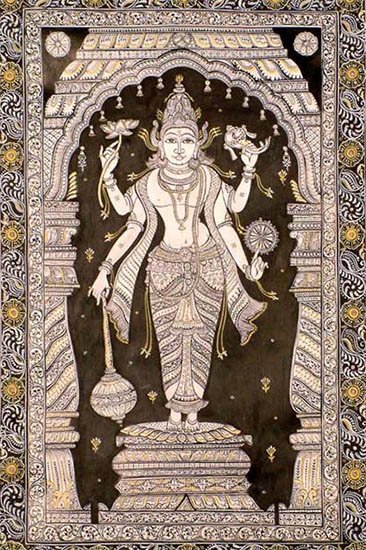Adinarayana, Ādinārāyaṇa, Adi-narayana: 3 definitions
Introduction:
Adinarayana means something in Hinduism, Sanskrit, Marathi. If you want to know the exact meaning, history, etymology or English translation of this term then check out the descriptions on this page. Add your comment or reference to a book if you want to contribute to this summary article.
In Hinduism
Shilpashastra (iconography)
Source: Shodhganga: The significance of the mūla-beras (śilpa)Ādinārāyaṇa (or Ādi Nārāyaṇan Perumāl) is the name of a deity depicted at the Ranganathaswamy Temple in Srirangam (Śrī Raṅgam), which represents a sacred place for the worship of Viṣṇu.—The deity Ādi Nārāyaṇan Perumāl is found in padmāsana posture with four hands. The upper hands hold cakra and śaṅkh in the right and the left hands are in kartarīmukha-hasta. The lower hands are held in dhyāna-mudrā near the navel. Mudalālvārs are found in front of the deity in samapāda-sthānaka with hands in añjali posture.

Shilpashastra (शिल्पशास्त्र, śilpaśāstra) represents the ancient Indian science (shastra) of creative arts (shilpa) such as sculpture, iconography and painting. Closely related to Vastushastra (architecture), they often share the same literature.
Languages of India and abroad
Marathi-English dictionary
Source: DDSA: The Molesworth Marathi and English Dictionaryādinārāyaṇa (आदिनारायण).—m (S) A name of viṣṇu or nārāyaṇa as the First cause.
Marathi is an Indo-European language having over 70 million native speakers people in (predominantly) Maharashtra India. Marathi, like many other Indo-Aryan languages, evolved from early forms of Prakrit, which itself is a subset of Sanskrit, one of the most ancient languages of the world.
Kannada-English dictionary
Source: Alar: Kannada-English corpusĀdinārāyaṇa (ಆದಿನಾರಾಯಣ):—[noun] an epithet of Viṣṇu.
Kannada is a Dravidian language (as opposed to the Indo-European language family) mainly spoken in the southwestern region of India.
See also (Relevant definitions)
Partial matches: Adi, Narayana.
Starts with: Atinarayanan.
Full-text: Kunampatti.
Relevant text
Search found 8 books and stories containing Adinarayana, Ādinārāyaṇa, Adi-narayana, Ādi-nārāyaṇa; (plurals include: Adinarayanas, Ādinārāyaṇas, narayanas, nārāyaṇas). You can also click to the full overview containing English textual excerpts. Below are direct links for the most relevant articles:
The Skanda Purana (by G. V. Tagare)
Chapter 84 - Greatness of Ādinārāyaṇa < [Section 1 - Prabhāsa-kṣetra-māhātmya]
Chapter 85 - Greatness of Sannihitā < [Section 1 - Prabhāsa-kṣetra-māhātmya]
Middle Chola Temples (by S. R. Balasubrahmanyam)
Temples in Seramadevi < [Chapter II - Temples of Rajaraja I’s Time]
Book Reviews < [April – June and July – September, 1996]
Puranic encyclopaedia (by Vettam Mani)
Sanskrit sources of Kerala history (by Suma Parappattoli)
17. Syanandurapuravarnana-Prabandha by Rama Varma Swathi Thirunal < [Chapter 5 - Sanskrit Dramas and Campus bearing on Kerala History]
Lalitopakhyana (Lalita Mahatmya) (by G.V. Tagare)